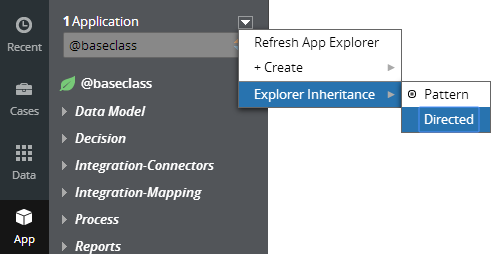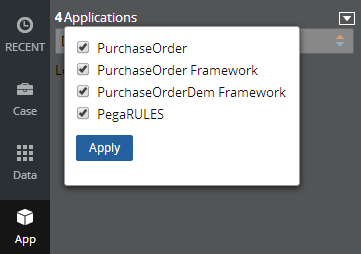Guardrails compliance score
Valid from Pega Version 7.1.5
The Application Guardrails landing page has been enhanced to help you build more guardrail-compliant applications. Increase transparency and accountability on your projects by responding to the following compliance score metrics:
- A weighted compliance score (0-100) based on warnings, severity, and justification
- A percentage of compliant rules in your application
- Total number of rules in your application
- Total number of rules in your application with warnings (justified and unjustified)
Additional metrics include alert and interaction count trends over the last four weeks.
For more information, see Guardrails compliance score.
Directed inheritance view in Application Explorer
Valid from Pega Version 7.1.5
You can now specify which inheritance model is used to populate classes in the Application Explorer. From the top level menu, use the “Explorer Inheritance” option to choose between:
- Pattern: only display class names whose prefix matches the root node class name.
- Directed: first display classes that explicitly name the root node as the parent class; then display classes with pattern inheritance.

By default, the Application Explorer loads using Pattern inheritance.
Save Application Explorer filter selections
Valid from Pega Version 7.1.5
Application scoping control selections made in the Application Explorer are now persisted between sessions. These preferences are stored in an operator record on an access group level. If you delete (and later re-add) an access group on your operator form, the application scoping control defaults to all layers selected:

External access control DASS
Valid from Pega Version 7.1.5
A new Dynamic Admin System Setting (DASS) controls the Designer Studio's access to external systems, specifically the PDN RSS feed found on the home page.
By default, Pega-Desktop.AllowAccessToExternalSystem is set to TRUE. Update this setting to FALSE to hide the PDN RSS feed and ensure that no RSS fetch is performed.
App Studio enhancements further support Pega Express methodology
Valid from Pega Version 8.6
App Studio now includes improvements that you can use to plan your Microjourney™ in a more convenient way. The Overview workspace now includes a button to edit application details, such as name, description, and business objectives, without having to switch to Dev Studio. You can also access relevant information faster, because Case Designer displays additional details about channels, data objects, and attachments associated with a case type directly in a properties pane. For improved management of your features, feature categories are now available in the application inventory so that you can clearly communicate to your development team what type of features need implementation.
For more information, see:
- Editing application details in App Studio
- Associating personas with channels
- Adding features to application inventory
- Creating a Microjourney for customer success
Enhanced mapping of personas and users in App Studio
Valid from Pega Version 8.6
App Studio now provides a consistent and transparent experience when mapping personas to users. When you invite users to your application, you can associate each user with a run-time persona or developer role by selecting an option from a clearly organized list. For example, you can associate run-time users with a customer service representative persona, and then invite a person to help develop your application and assig them a developer role. For greater clarity, personas now replace references to roles in App Studio.
For more information, see Inviting collaborators to your application.
Tracer support for Cosmos React
Valid from Pega Version 8.6
The Tracer tool is now available for stateless applications, so that you can trace and debug applications that you build on Cosmos React. Because in a stateless application multiple requests can run simultaneously, to provide clarity, Tracer shows the events by request ID instead of grouping the events by the time of occurrence. For greater convenience, debugging Cosmos React applications is also available in an offline Tracer tool. As a result, you speed up the development process and deliver top-quality applications that are free of bugs.
For more information, see:
- Debug your Cosmos React applications faster with Tracer (8.6)
- Application debugging by using the Tracer tool
- Pega Digital Experience (DX) API
- Cosmos React
Nested conditions visible in the condition builder
Valid from Pega Version 8.6
Condition builder now supports the option to view nested conditions in a read-only mode, so that you can conveniently analyze and understand logic in your application. For example, if you create a condition that uses another When condition rule as a value to compare at run time, you can preview the configuration of that When condition. You can use this feature with When conditions nested at multiple levels, so that you can analyze even complex logic in your application.
For more information, see Defining conditions in the condition builder.
More detailed configuration of persona access in App Studio
Valid from Pega Version 8.6
App Studio now supports more precise configuration of access for personas so that you can improve the security and usability of your application. You can now define what actions a given persona can perform on a case, a data object, or a configuration set. You also save time because you define settings for an entire group of users that a persona represents. For example, you can configure a customer service representative (CSR) persona to view only cases that process insurance claims from VIP customers, without the option to modify the cases. As a result, you ensure that users of your application can interact only with relevant data, in a way that best meets your business needs.
For more information, see:
- Manage access for personas more efficiently in App Studio (8.6)
- Configuring access options for a persona
Decision tables authoring in App Studio
Valid from Pega Version 8.6
App Studio now supports the option to create decision tables that return values for a calculated field. For example, you can automatically calculate a life insurance rate for a customer by using a decision table that evaluates multiple factors, such as age, medical history, and current occupation. At run time, your application evaluates the values that the customer provides against the values in the decision table, and then responds with the most suitable result. By building decision tables in App Studio, you increase the flexibility of your low-code application and save time and resources, because a single decision table can provide results in multiple scenarios. You can also save and then reuse decision tables to speed up your application development even more.
For more information, see:
- Calculate values automatically in App Studio with decision tables (8.6)
- Calculating values with decision tables
- Authoring decision tables in App Studio

